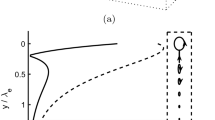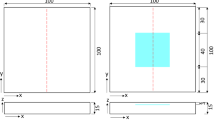Abstract
Quantitative nondestructive evaluation based on the use of transient stress waves generated by point impact is hindered by the fact that the governing partial differential equations admit closed-form solutions for only the most trivial cases, an infinite half-space and an infinite plate. In previous studies carried out by the authors, the finite element method has been shown to provide useful numerical solutions for a variety of cases involving bounded solids containing flaws. Numerical results have been verified with carefully controlled experiments. Currently, the method is being used to establish the basis for a new nondestructive evaluation technique for civil engineering structures. This technique is called impact-echo, and it is based on the use of low frequency, transient stress waves generated by elastic point impact. In this paper, the impact-echo response of plates containing thin layers is studied using finite element models. The purpose of these studies was to determine the applicability of using the method for detecting voids in layered civil engineering structures. Results of the numerical studies show that it is feasible to use the impact-echo method for this application.
Similar content being viewed by others
References
M. Sansalone and N. J. Carino, Impact-Echo: A Method for Flaw Detection in Concrete Using Transient Stress Waves, NBSIR 86-3452, NTIS PB No. 87-104444/AS, Springfield, Virginia, September, 1986.
M. Sansalone, N. J. Carino, and N. N. Hsu, A finite element study of transient wave propagation in plates,NBS J. Res. (July/August): 267–278 (1987).
M. Sansalone, N. J. Carino, and N. N. Hsu, A finite element study of the interaction of transient stress waves with planar flaws,NBS J. Res. (July/August): 279–290 (1987).
M. Sansalone and N. J. Carino, Transient impact response of thick circular plates,NBS J. Res. (Nov./Dec.): 355–367 (1987).
M. Sansalone and N. J. Carino, Transient impact response of plates containing flaws,NBS J. Res. (Nov./Dec): 369–381 (1987).
M. Sansalone and N. J. Carino, Impact-echo method,Concrete Int. (April): 38–46 (1988).
N. J. Carino, M. Sansalone, and N. N. Hsu, Flaw detection in concrete by frequency spectrum analysis of impact-echo waveforms,Int. Adv. Nondestr. Testing 12:117–146 (1986).
M. Sansalone and N. J. Carino, Detecting delaminations in concrete slabs with and without overlays using the impact-echo method,Mater. J. Am. Concrete Inst. 86:(March) 175–184 (1989).
M. Sansalone and N. J. Carino, Finite element studies of the impact-echo response of layered plates containing flaws,Int. Adv. Nondestr. Testing 15. In press.
J. O. Hallquist, A Procedure for the Solution of Finite Deformation Contact-Impact Problems by the Finite Element Method, Report No. UCRL-52006, Lawrence Livermore National Laboratory, April 1976.
J. O. Hallquist, User's Manual for DYNA2D: An Explicit Two-Dimensional Hydrodynamic Finite Element Code with Interactive Rezoning, Lawrence Livermore National Laboratory, Revised January 1984.
J. O. Hallquist, User's Manual for Maze: An Input Generator for DYNA2D and NIKE2D, Lawrence Livermore National Laboratory, June 1983.
J. O. Hallquist, User's Manual for ORION: An Interactive Post-Processor for the Analysis Code NIKE2D, DYNA2D, and TACO2D, Lawrence Livermore National Laboratory, July 1983.
R. Ludwig and W. Lord, A finite element formulation for ultrasonic NDT modeling, inReview of Progress in Quantitative Nondestructive Evaluation (Vol. 4), D. O. Thompson and D. E. Chimenti, eds. (Plenum, 1985), pp. 37–43.
R. Ludwig and W. Lord, Developments in the finite element modeling of ultrasonic NDT phenomena, inReview of Progress in Quantitative Nondestructive Evaluation (Vol. 5), D. O. Thompson and D. E. Chimenti, eds. (Plenum, 1986), pp. 73–81.
R. Ludwig and W. Lord, A finite element study of ultrasonic wave propagation in an aluminum block,Mater. Eval. 46(January):108–113 (1988).
R. Ludwig and W. Lord, A finite element formulation for the study of ultrasonic NDT systems,IEEE Trans. Ultrasonics, Ferroelectrics, Frequency Control 35(6):809–820 (1988).
R. Ludwig and W. Lord, A theoretical and numerical study of transient force excitation on an elastic half-space,IEEE Trans. Ultrasonics, Ferroelectrics, Frequency Control 36(3):342–350 (1989).
M. Sansalone, Y. Lin, and N. J. Carino, Impact-echo response of plates containing thin layers and voids, inProceedings of the Review of Progress in Quantitative Nondestructive Evaluation (Bowden, Maine, July 1989).
N. J. Carino and M. Sansalone, Detecting voids in grouted tendon ducts using the impact-echo method, InProceedings of the RILEM International Workshop on Testing During Concrete Construction (Mainz, W. Germany, March 1990).
Author information
Authors and Affiliations
Rights and permissions
About this article
Cite this article
Lin, Y., Sansalone, M. & Carino, N.J. Finite element studies of the impact-echo response of plates containing thin layers and voids. J Nondestruct Eval 9, 27–47 (1990). https://doi.org/10.1007/BF00566980
Received:
Revised:
Issue Date:
DOI: https://doi.org/10.1007/BF00566980




